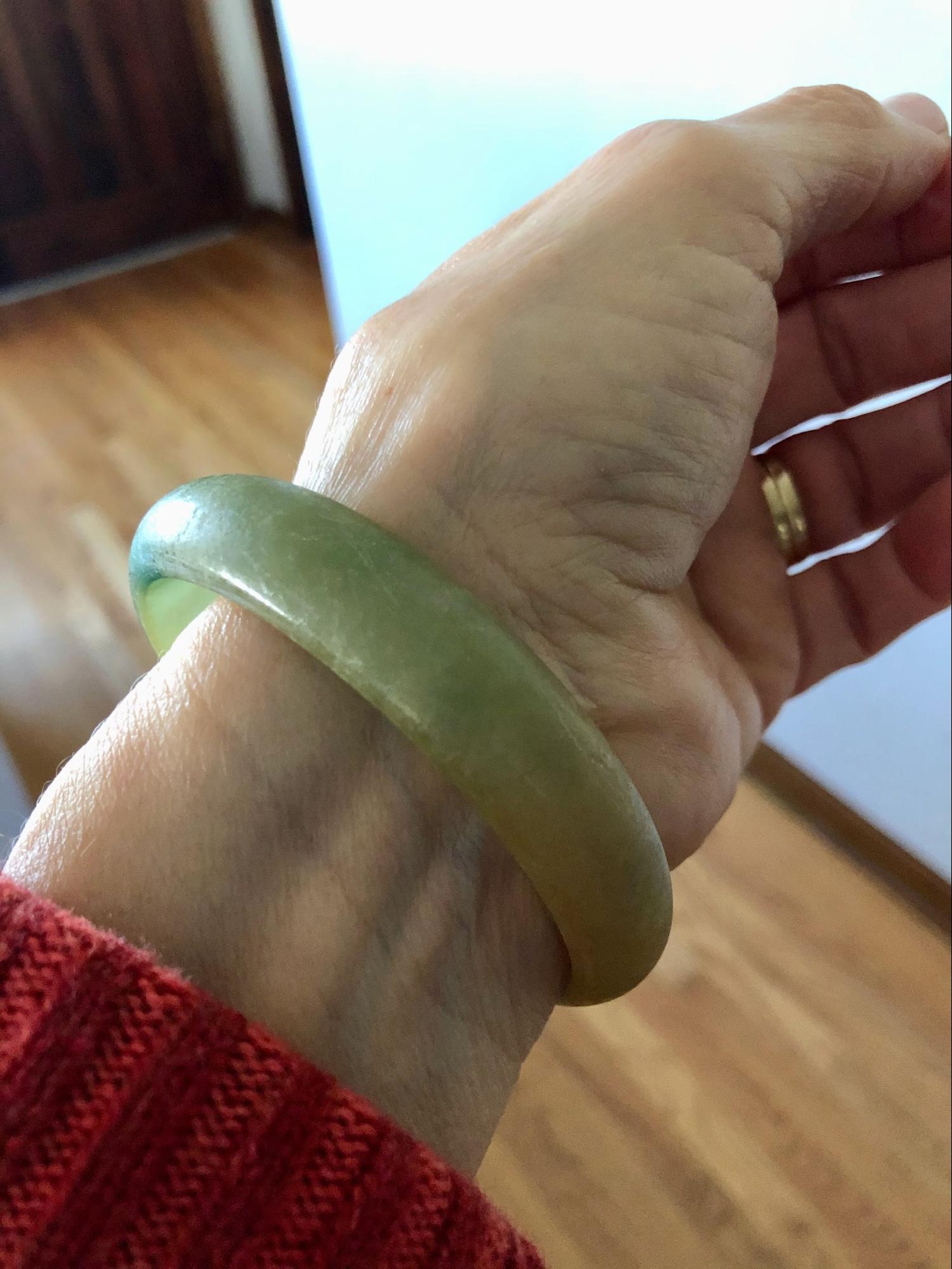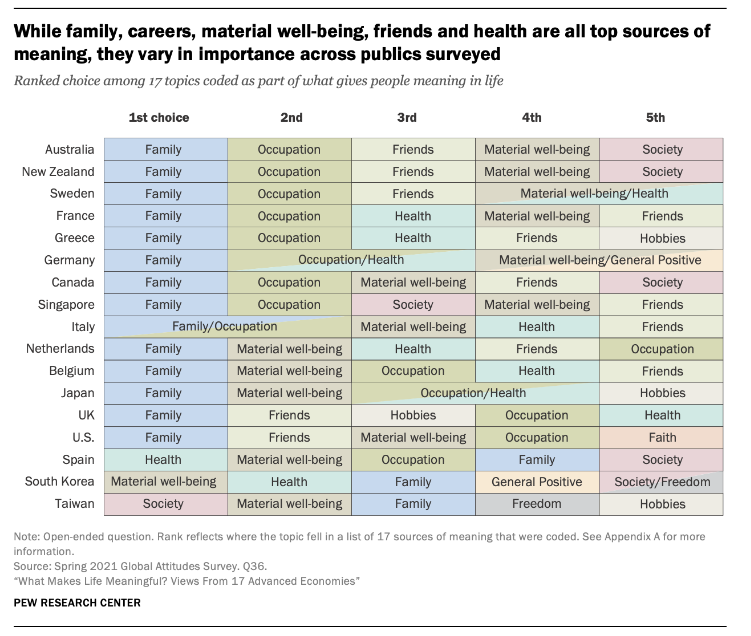14.3 Purpose and Meaning: A Survey of 17 Countries
Elizabeth B. Pearce and Nadine Wood
In this section we will look at survey data to define what purpose and meaning looks like to people from 17 industrialized countries, mostly that are part of the western world such as France, Germany, and the United States, or considered to be westernized, such as Japan, South Korea, and Taiwan.
As you read, consider how two psychologists described meaning in The Journal of Positive Psychology in 2016. They describe these three aspects of meaning (Martela & Steger, 2016):
- Coherence is how events fit together. This is an understanding that things happen in your life for a reason. That doesn’t necessarily mean you can fit new developments into your narrative the moment they happen, but you usually are able to do so afterward, so you have faith that you eventually will.
- Purpose is the existence of goals and aims. This is the belief that you are alive in order to do something. Think of purpose as your personal mission statement, such as “the purpose of my life is to share the secrets to happiness” or “I am here to spread love abundantly.”
- Significance is life’s inherent value. This is the sense that your life matters. If you have high levels of significance, you’re confident that the world would be a tiny bit—or perhaps a lot—poorer if you didn’t exist.
As you read, consider the aspects of coherence, purpose, and significance. See if you recognize how what gives people meaning may reflect one or more of these parts of meaning.
Studying Meaning in 17 Advanced Economies
Nineteen thousand adults from 17 advanced economies, including the United States, were surveyed by Pew Research Center in 2021, about what people value in life, and what gives their lives meaning. What do you think was the number one response across the majority (14) of these publics including the United States? It was “family” (Mitchell, 2021).
So here you are, reading a text about what families need, and specifically the chapter about the need for purpose and meaning in life. It turns out that many people in industrialized countries answer the question about what gives their lives meaning with what we are studying, “family.”
In Focus: Bracelet Full of Meaning

I purchased a Jade bracelet in 2010 while on a Homeland Tour in China with my husband and our two daughters. Overall the bracelet symbolizes the deep connection our family will always have to China. The stone, carved into a circle, conveys the stable and unwavering love I have for our daughters. Over the years, the Jade has become scratched and dull on the outside yet remains smooth and shiny on the inside, which reminds me of the joys and challenges of parenting and being in a relationship. Because I wear this bracelet day and night, I can forget it is there. Then, the stone clangs on the counter or becomes warm in the dishwater, and the sensation alerts me—and reminds me.
Pew Research asked this open-ended question, “We’re interested in exploring what it means to live a satisfying life. What aspects of your life do you currently find meaningful, fulfilling, or satisfying?” When individuals spoke about family, they elaborated by describing relationships with parents, siblings, children, and grandchildren. They mentioned spending quality time with relatives and taking pride in their accomplishments. In addition, they spoke of working to leave an improved world for their children (Mitchell, 2021).
Here are two detailed responses from individuals in the United States (Pew Research Center, 2021):
Having someone I love in my life, around me every day, makes life a lot more satisfying! Also friends and family. Aside from that, I have a strong creative urge. For example…what really gets me going is thinking about the YouTube channel I plan on starting. I also create music, and I want to start writing fiction and possibly design an adventure game.…I have anxiety that makes me hesitant to put my work out there, but I know that’s what I want. I know that’s the only thing that can really satisfy me.…Anything I can do to get myself past that feeling of “I can’t do it…it’s not worth it…what’s the point…” will lead me down deeply meaningful, fulfilling and satisfying avenues of creativity.
—Male, 33
Being comfortable and stable with basic needs (food, shelter, health care, and public education for my child) and a little extra (maybe going out to dinner or a vacation). Being fulfilled with experiences and personal relationships and not so much stuff. What makes this life worth living is good health, strong healthy relationships, being in awe of all the natural beauty in this world, learning new things daily and guiding my son into a life where he is a healthy, empathic, self-reliant, and loving adult. (And of course: cats! lol)
—Female, 51
In the responses above, you can see that participants had the ability to respond with a wide range of answers, from which researchers extrapolated data that is more organized and easier to generalize.
You’ll notice in the first quote that the 33-year-old male also highlighted that creativity was an important part of what gives his life meaning. Creativity is defined as “the tendency to generate or recognize ideas, alternatives, or possibilities that may be useful in solving problems…and entertaining ourselves and others (Franken, 2011).” Creativity is not one of the categories that the researchers identified. Perhaps they coded this man’s comment as “hobbies” or “freedom.” Theorists, however, identify creativity as a part of generativity, which will be discussed in the next section.
Activity: What Is Meaningful to You?
How would you answer the question used in the Pew Research Center Survey?
“What aspects of your life do you currently find meaningful, fulfilling, or satisfying?”
- Respond to the question above in a narrative form.
- As you answer, try to be authentic to your own thoughts and feelings. Remember, the original respondents did not have access to the coding and categories that the researchers used to present the narrative information in a quantitative fashion, so write freely.
- Trade responses with a classmate. After reading each other’s narratives and reviewing the topics listed here (View a Topic), discuss how your narratives fit into the topics.
- And what did you write about that does not fit into a survey topic?
Also ranked highly, as shown in figure 14.5, were the following categories:
- Friends
- Occupation
- Health
- Material well-being
- Society

Comparing the United States to Other Countries
Viewing figure 14.5, you can see similarities and differences amongst countries, including that family was the first choice for most countries, including the United States. When you look over to the second choice, however, it is evident that only the United States and the United Kingdom chose “friends,” while most other countries chose “material well-being” or “occupation,” both of which are more related to income.
Also noticeable in the chart is that the United States is the only country in which the majority of respondents included “faith” in the top five choices. In this survey, faith, spirituality, and religion were grouped together. “Faith” includes personal ways of finding meaning and worshiping, peace of mind, as well as organized religion, rites, and rituals. Fifteen percent of Americans mentioned spirituality, faith, or religion when saying what gives them meaning. The next highest response came from New Zealand, with 5% of respondents giving similar answers.
While spouses and romantic partners were not mentioned as frequently as family or children, they were mentioned the most by respondents from the United States compared to other countries, including an American woman who said of her husband, “He is thoughtful and supportive and gives me ground to stand on when everything else falls apart” (Pew Research Center, 2021). Nine percent of respondents from the United States included “partners” as giving life meaning.
You may be wondering about how people with differing social identities spoke about what was meaningful to them. Let’s look at a couple of the patterns that were found. Use your sociological imagination to compare and contrast broad societal patterns to what is meaningful to you in your own life.
Comparisons by Age
Respondents between the ages of 18 and 29 are most likely to mention friends and community as bringing meaning to their lives. In addition, those under 30 are more likely to consider jobs, education, and hobbies as important than older people.
While adults of all ages ranked family strongly, those aged 30 to 49 are the ones most likely to mention family. This is also the age when most people are likely to have children at home (OECD, 2022). Those older than 65 were more likely to mention “health” and “retirement” as meaningful in their lives.
Comparisons by Sex and Gender
Women were more likely than men to include family or children in their responses about meaning in life. This gender gap was highest in countries where family was ranked higher overall (New Zealand, Canada, and others) and lowest in countries that did not include family as frequently, such as South Korea, Singapore, and Japan. Women also mentioned their health more often than did men (Pew Research Center, 2021).
Comparisons by Socioeconomic Status
Education and income were both reported by the survey participants. Overall, people with higher levels of education and higher incomes were more likely to mention their family and career as meaning-makers. Service and civic engagement were linked to people with more education. Lastly, those with lower incomes were more likely to say that they had challenges in their lives related to finding meaning and purpose (Pew Research Center, 2021).
Comprehension Self Check
Licenses and Attributions for Purpose and Meaning: A Survey of 17 Countries
Open Content, Original
“Purpose and Meaning: A Survey of 17 Countries” by Elizabeth B. Pearce. License: CC BY 4.0.
“In Focus: A Bracelet Full of Meaning” by Nadine Wood. License: CC BY-NC-ND 4.0.
Figure 14.4. Photograph by Nadine Wood. License: CC BY 4.0.
All Rights Reserved Content
Figure 14.5. “While Family, Careers, Material Well-Being, Friends and Health Are All Top Sources of Meaning, They Vary in Importance across Publics Surveyed” from “What Makes Life Meaningful? Views from 17 Advanced Economies” © Pew Research Center, Washington, D.C. License: Pew Research Center’s Terms of Use.
References
Franken, C. (2001) A.S. Byatt: art, authorship, creativity. Palgrave, Basingstoke, UK.
Martela, F., & Steger, M. F. (2016). The three meanings of meaning in life: Distinguishing coherence, purpose, and significance. The Journal of Positive Psychology, 11(5), 531–545. https://doi.org/10.1080/17439760.2015.1137623
Mitchell, T. (2021, November 18). What makes life meaningful? Views from 17 advanced economies. Pew Research Center’s Global Attitudes Project. https://www.pewresearch.org/global/2021/11/18/what-makes-life-meaningful-views-from-17-advanced-economies/
OECD Family Database. OECD. (2022, June). Retrieved April 7, 2023, from https://www.oecd.org/els/family/database.htm https://www.oecd.org/els/soc/SF_2_3_Age_mothers_childbirth.pdf
Pew Research Center. (2021). Where people around the world find meaning in life [Infographic]. https://www.pewresearch.org/global/interactives/meaning-in-life/
a method by which sociologists gather their data by asking questions.
can include the aim, goal, or intention of an action; a long-term guiding principle; the impact our life has on the world.
can include the emotional significance of an action or way of being; the intention or reason for doing something; something that we create and feel; closely linked to motivation.
the state of complete physical, mental, and social well-being and not merely the absence of disease or infirmity.
the concern for the future and one’s own contribution to the next generation.
the developmental changes and transitions that come with being a child, adolescent, or adult.
a socially constructed expression of a person’s sexual identity which influences the status, roles, and norms for their behavior.

